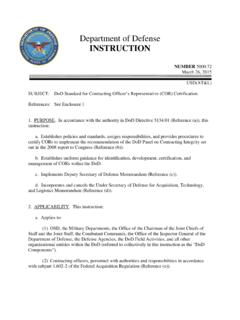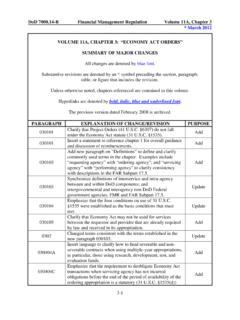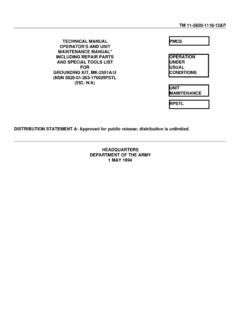Transcription of DoD Strategy for Defending Networks, Systems, …
1 distribution A: approved for public release ; distribution is unlimited DoD Strategy for Defending Networks, Systems, and Data DoDD November 13, 2013 Department of Defense Chief Information Officer distribution A: approved for public release ; distribution is unlimited DoD Strategy for Defending Networks, Systems, and Data 1 DoD Strategy for Defending Networks, Systems, and Data Introduction In July 2011, the Department of Defense (DoD) published the DoD Strategy for Operating in Cyberspace (DSOC), stemming from strategic threads outlined in the 2010 Quadrennial Defense Review and 2010 National Security Strategy . The DSOC specifies that cyberspace is an operational domain and DoD should focus its efforts on mission assurance and the preservation of critical operating capabilities. Strategic Initiative 2 of the DSOC (Employ New Defense Operating Concepts to Protect DoD Networks and Systems) called for the implementation of constantly evolving defense operating concepts to achieve DoD s cyberspace mission requirements.
2 This DoD Strategy for Defending Networks, Systems, and Data responds to that requirement as well as other related DSOC initiatives, and identifies strategic imperatives to ensure the protection, integrity, and assurance of DoD cyber1 assets. Objectives of this Strategy are to: Identify strategic imperatives required to focus and transform DoD cybersecurity and cyber defense operations Reshape DoD cyber culture, technology, policy, and processes to focus on achieving warfighter missions and needs Ensure networks and systems are capable of operating in contested cyber environments Position DoD to execute its role in Defending the Nation against cyber attacks Situation DoD relies heavily on cyberspace to enable its military, intelligence, and business operations, including the movement of personnel and material, and the command and control of the full spectrum of military operations. Exploitation of cyber vulnerabilities could undermine DoD s ability to operate and threaten our national security and economic competitiveness.
3 DoD investments in cybersecurity have improved the security posture of DoD networks, systems, and data by reducing attack surfaces and improving control over information access. Results include enhancements in cybersecurity measures and situational awareness, such as monitoring for intrusions, mitigation of vulnerabilities, improved identity management and authentication, and central collection of incident data. However, the cyber threat is increasing, and adversaries are becoming more skilled, sophisticated, and strategically-minded. Four Strategic Focus Areas To meet the challenges expected between now and 2020, transformational changes to DoD s cyber culture, workforce, technology, policy, and processes are required. The results of this Strategy will enable DoD to continue to operate effectively in cyberspace, as well as actively defend against adversarial cyber actions. By pursuing the following strategic efforts, DoD will greatly improve its cyber defenses. These initiatives will capitalize on down payments that have been made in each area, yet the current fiscal climate will further challenge the Department to make smart investment choices.
4 These four focus areas and their critical elements are necessary to achieve DoD s cyber mission now and in the future: 1 For the purposes of this Strategy , the terms cyberspace and cyber are used interchangeably and have the same meaning distribution A: approved for public release ; distribution is unlimited DoD Strategy for Defending Networks, Systems, and Data 2 1) Establish a Resilient Cyber Defense Posture 2) Transform Cyber Defense Operations 3) Enhance Cyber Situational Awareness 4) Assure Survivability against Highly-Sophisticated Cyber Attacks In these efforts, DoD will work more closely with interagency, private sector, and international partners toward collective cyber defense. Most importantly, the DoD cyberspace workforce will be fully trained, equipped, and prepared for cyber defense of DoD and the Although not addressed as a critical element, each focus area will require development of related policy, oversight, and compliance mechanisms. The results of this Strategy will produce an achievable end state: mission dependability in the face of a capable cyber adversary.
5 Table 1. Summary of Focus Areas and Associated Critical Elements Focus Areas Critical Elements Establish a Resilient Cyber Defense Posture Architect a Defensible Information Environment Enhance Security through Cyber Hygiene and Best Practices Strengthen Data Defenses Increase Focus on Industrial Control Systems and Embedded Computing Institutionalize Threat-Based Engineering and Acquisition Transform Cyber Defense Operations Improve Active Cyber Defense Capabilities Mitigate All Phases of Cyber Aggression Ready Forces to Maneuver Employ Unpredictable Defenses Enhance Cyber Situational Awareness Improve the Cyber Sensing Infrastructure Harness the Power of Big Data Analytics Implement a Multi-Mission Cyber Operational Picture Increase Information Sharing and Cooperation Assure Survivability against Highly-Sophisticated Cyber Attacks Assure Survivability of High Priority Mission Areas Prepare for Success Against Large-Scale Cyber Attacks Quickly
6 Regenerate Cyber Capabilities Focus Area 1: Establish a Resilient Cyber Defense Posture The first strategic imperative, establishing a resilient cyber defense posture, will be achieved through personal security practices, architecture and engineering, and delivery of new capabilities and solutions to address shortfalls in the current DoD Information and Communication Technology (ICT) infrastructure In addition to the ongoing efforts to provide secure enterprise services, further transformational efforts are required, including secure interoperation with partners. Critical elements include: 2 A complementary, comprehensive DoD Cyberspace Workforce Strategy is in development; therefore, specific workforce recommendations are not included in this Strategy document except where part of a broader context. 3 ICT is defined in DODI , dated 5 November 2012 distribution A: approved for public release ; distribution is unlimited DoD Strategy for Defending Networks, Systems, and Data 3 Architect a Defensible Information Environment.
7 Defending DoD networks against high-tier and advanced threats ( , Nation-state adversaries) begins with a defensible architecture that must maintain a high level of operational readiness. Migration to a Joint Information Environment (JIE) will provide a flexible joint warfighting information environment through a shared information technology (IT) infrastructure, enterprise services, coherence with Intelligence Community (IC) capabilities, and a joint security architecture that collectively increases mission effectiveness and enables cyber defense efforts. This JIE security architecture will facilitate technology acquisition and insertion, allow for rapid mitigation response against new threats, increase resilience, and support active cyber defense. Enhance Security through Cyber Hygiene and Best Practices. Maintaining a defensible network with a high level of operational readiness begins with sound architectural principles that must include cyber hygiene and best practices to maintain the health and resiliency of the network .
8 Cyber hygiene drives network / system health and includes protection, monitoring, maintenance, and design for networks and systems to assure their security and integrity. Ultimately, cyber hygiene strives to create a secure environment that impedes the adversary s ability to gain access, establish a presence and infiltrate deeper in the network , and attack or exfiltrate data in the network . At a basic level, cyber hygiene includes the best practices of hardware and software asset management, along with management of configuration settings and patch level. Increasing understanding of where and how to interrupt the intrusion lifecycle is critical to designing capabilities that harden and defend the cyber enterprise against attack. Strengthen Data Defenses. Ensuring the confidentiality and integrity of information throughout its lifecycle ( , create, transmit, process, and store) is critical to maintaining end-user trust in DoD systems. Robust identities based on public key infrastructure (PKI) and other cryptographic-based technologies are already building a foundation for protecting and sharing information within DoD as well as collaboration with partners.
9 Strong cryptographic-based defenses will become increasingly practical to protect data integrity and confidentiality. Continual modernization and strengthening of current cryptography and key management efforts are required to keep ahead of adversary advances. Finally, DoD will develop and use enhanced metadata tagging and richer access control techniques to improve data access management and discovery. Increase Focus on Industrial Control Systems (ICS) and Embedded Computing. As ICS and Supervisory Control and Data Acquisition (SCADA) systems are becoming more integrated with IT networks, and embedded IT components are becoming ubiquitous across major weapon systems and tactical communications systems, there is a greater need to secure these systems from remote, external threats both on and off the battlefield. Institutionalize Threat-Based Engineering and Acquisition. By addressing cyber threats during the full life-cycle of acquisition programs, DoD will design, procure, field, and maintain trustworthy, resilient DoD networks, information systems, and weapon systems.
10 DoD will strengthen requirements, acquisition policies, and directives to ensure that cybersecurity is recognized as essential to achieving capability requirements ( , as a key performance parameter) in all DoD acquisitions and that systems security engineering is an early and integral part of all efforts. Engineers, acquisition managers, and logisticians need to integrate cybersecurity strategies more effectively into existing Program Protection Planning, acquisition distribution A: approved for public release ; distribution is unlimited DoD Strategy for Defending Networks, Systems, and Data 4 oversight processes, and supply chain management. This will ensure that cybersecurity is inherent in the system design, maturing across the lifecycle, and program management decisions are informed by the risks the program is expected to face. Focus Area 2: Transform Cyber Defense Operations The second strategic imperative is to shift from reactive cyber defense operations to operations that focus a greater portion of their efforts on adversary activities and intent.








